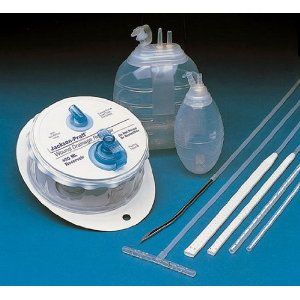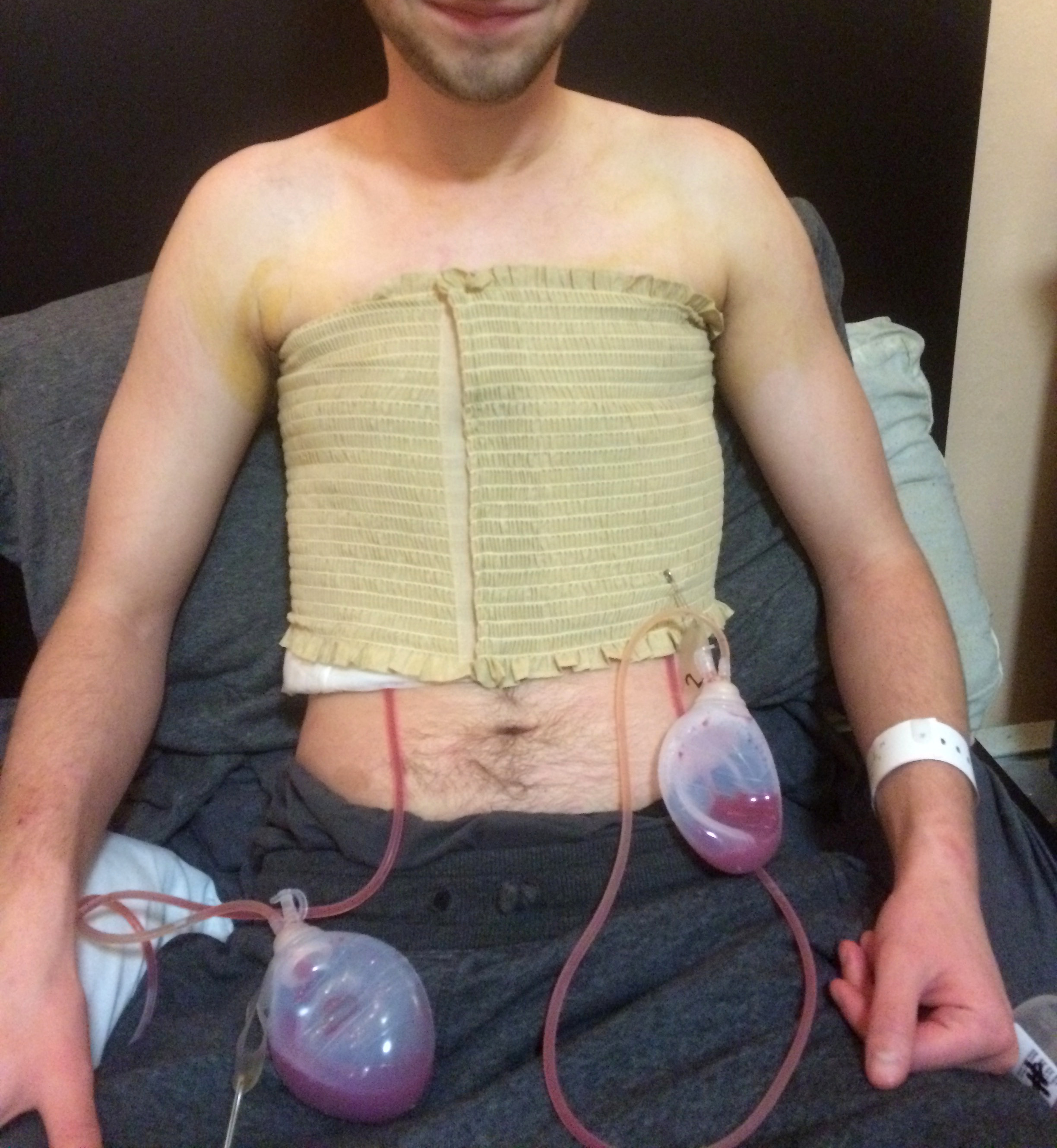Jackson-Pratt drain on:
[Wikipedia]
[Google]
[Amazon]

 A Jackson-Pratt drain (also called a JP drain) is a closed-suction medical device that is commonly used as a post-operative drain for collecting bodily fluids from surgical sites. The device consists of an internal drain connected to a grenade-shaped bulb or circular cylinder via plastic tubing.
The purpose of a drain is to prevent fluid (blood or other) build-up in a closed ("dead") space,MedlinePlus Medical Dictionary, "Dead Space", http://www.merriam-webster.com/medlineplus/dead%20space which may cause either disruption of the wound and the healing process or become an infected abscess, with either scenario possibly requiring a formal drainage/repair procedure (and possibly another trip to the operating room). The drain is also used to evacuate an internal abscess before surgery when an
A Jackson-Pratt drain (also called a JP drain) is a closed-suction medical device that is commonly used as a post-operative drain for collecting bodily fluids from surgical sites. The device consists of an internal drain connected to a grenade-shaped bulb or circular cylinder via plastic tubing.
The purpose of a drain is to prevent fluid (blood or other) build-up in a closed ("dead") space,MedlinePlus Medical Dictionary, "Dead Space", http://www.merriam-webster.com/medlineplus/dead%20space which may cause either disruption of the wound and the healing process or become an infected abscess, with either scenario possibly requiring a formal drainage/repair procedure (and possibly another trip to the operating room). The drain is also used to evacuate an internal abscess before surgery when an
The Cleveland Clinic
from Drugs.com {{Surgical instruments Medical drains

infection
An infection is the invasion of tissues by pathogens, their multiplication, and the reaction of host tissues to the infectious agent and the toxins they produce. An infectious disease, also known as a transmissible disease or communicable di ...
already exists.Patient.co.uk, "Surgical Drains - Indications, Management and Removal", http://www.patient.co.uk/doctor/Surgical-Drains-Indications-Management-and-Removal.htm Clots and other solid matter in the drainage fluid may occlude the tubing, preventing the device from draining properly.
Care and maintenance
The flexible bulb has a plug that can be opened to pour off collected fluid. Each time fluid is removed, the patient, caregiver or healthcare provider squeezes the air out of the bulb and replaces the plug before releasing the bulb. The resulting vacuum creates suction in the drainage tubing, which gradually draws fluid from the surgical site into the bulb. The bulb may be repeatedly opened to remove the collected fluid and squeezed again to restore suction. It is best to empty drains before they are more than half full to avoid the discomfort of the weight of the drain pulling on the internal tubing. JP drains come in flat and round forms, and these are available in varying sizes. The flat drains are measured in millimeters, and the round drains are measured in French sizes.http://www.cardinalhealth.com/us/en/distributedproducts/ASP/JP-HGF073.asp?cat=med_surg-orig Patients or caretakers can "strip" the drains by taking a damp towel or piece of cloth and bracing the portion of the tubing closest to the body with their fingers, run the cloth down the length of the tube to the drain bulb. One can also put a little bit of lotion ormineral oil
Mineral oil is any of various colorless, odorless, light mixtures of higher alkanes from a mineral source, particularly a distillate of petroleum, as distinct from usually edible vegetable oils.
The name 'mineral oil' by itself is imprecise ...
on their fingertips to lubricate the tube to make stripping easier. The portion of the tube closest to the exit point of the drain from the body should be gripped first, and once the length of the drain is stripped, the end closest to the surgical site should then be released. This increases the level of suction and helps to move clots through the drainage tube into the bulb.
It is important to watch the skin around the drain for signs of possible infection
An infection is the invasion of tissues by pathogens, their multiplication, and the reaction of host tissues to the infectious agent and the toxins they produce. An infectious disease, also known as a transmissible disease or communicable di ...
: increased redness, pain, or swelling; fever greater than 101 °F; cloudy yellow, tan, or foul-smelling drainage.National Institute of Health (USA), Clinical Center, "How to Care for the Jackson-Pratt Drain" (PDF) http://www.cc.nih.gov/ccc/patient_education/pepubs/jp.pdf
Any closed suction drain system, like the Jackson-Pratt, can become clogged with fibrin or clot. This results in loss of drain patency and thus fluid, blood or infected material can build up in the wound resulting in a wound hematoma and or abscess. Careful attention should be directed to make sure the drains do not clot or become clogged when they are still in use. This risk can be reduced by a daily subcutaneous injection
Subcutaneous administration is the insertion of medications beneath the skin either by injection or infusion.
A subcutaneous injection is administered as a bolus into the subcutis, the layer of skin directly below the dermis and epidermis, c ...
of low-molecular-weight heparin (LMWH) until the surgical drain is removed.
Common uses
*Abdominal surgery
The term abdominal surgery broadly covers surgical procedures that involve opening the abdomen ( laparotomy). Surgery of each abdominal organ is dealt with separately in connection with the description of that organ (see stomach, kidney, liver, ...
* Breast surgery
Breast surgery is a form of surgery performed on the breast.
Types
Types include:
*Breast reduction surgery
*Augmentation mammoplasty
* Mastectomy
*Lumpectomy
*Breast-conserving surgery, a less radical cancer surgery than mastectomy
*Mastopexy, ...
* Craniotomy
A craniotomy is a surgical operation in which a bone flap is temporarily removed from the skull to access the brain. Craniotomies are often critical operations, performed on patients who are suffering from brain lesions, such as tumors, blood clot ...
* Mastectomy
Mastectomy is the medical term for the surgical removal of one or both breasts, partially or completely. A mastectomy is usually carried out to treat breast cancer. In some cases, women believed to be at high risk of breast cancer have the operat ...
* Thoracic surgery
Cardiothoracic surgery is the field of medicine involved in surgical treatment of organs inside the thoracic cavity — generally treatment of conditions of the heart (heart disease), lungs (lung disease), and other pleural or mediastinal stru ...
* Joint replacement
Replacement arthroplasty (from Greek ''arthron'', joint, limb, articulate, + ''plassein'', to form, mould, forge, feign, make an image of), or joint replacement surgery, is a procedure of orthopedic surgery in which an arthritic or dysfunctional ...
(arthroplasty
Arthroplasty (literally " e-orming of joint") is an orthopedic surgical procedure where the articular surface of a musculoskeletal joint is replaced, remodeled, or realigned by osteotomy or some other procedure. It is an elective procedure that i ...
)
Namesake
The Jackson-Pratt Drain (informally referred to as the "brain drain") was named after its inventors Drs. Fredrick E. Jackson (Chief, Department of Neurosurgical Surgery, Naval Hospital, Camp Pendleton, CA) and Richard A. Pratt (Naval Hospital, Camp Pendleton, CA). First publications mentioning this device appeared in 1971–1972.See also
*Instruments used in general surgery
There are many different surgical specialties, some of which require very specific kinds of surgical instruments to perform.
General surgery is a specialty focused on the abdominal contents, as well as the thyroid gland, and diseases involving ...
References
External links
The Cleveland Clinic
from Drugs.com {{Surgical instruments Medical drains